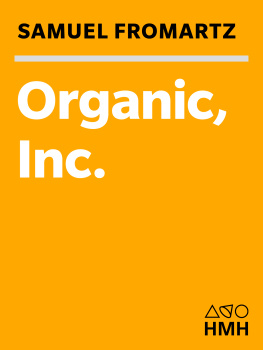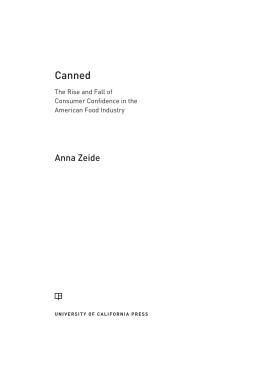Mention of specific companies, organizations, or authorities in this book does not imply endorsement by the author or publisher, nor does mention of specific companies, organizations, or authorities imply that they endorse this book, its author, or the publisher.
Internet addresses and telephone numbers given in this book were accurate at the time it went to press.
2014 by Joe Dobrow
All rights reserved. No part of this publication may be reproduced or transmitted in any form or by any means, electronic or mechanical, including photocopying, recording, or any other information storage and retrieval system, without the written permission of the publisher.
Book design by Amy C. King
Library of Congress Cataloging-in-Publication Data is on file with the publisher
ISBN-13: 978-1-62336-179-2
eISBN-13: 978-1-62336-180-8

We inspire and enable people to improve their lives and the world around them.
rodalebooks.com
C ONTENTS
It was 1996, and Whole Foods Market, Fresh Fields, and Wild Oats were waging a battle for customers, market share, and the soul of the natural foods industry.
In our grandparents era, virtually all food was natural. But then, in the blink of an eye, our food production system changed, abetted by the development and proliferation of DDT and other pesticides, synthetic fertilizers, and food additives.
Fueled by the convulsive social change of the 1960s, the health foods industry slowly began to emerge as an alternative to the pervasive new world of mass-produced, highly processed, plastic food.
Ironically, the counterculture movement wound up producing some of the countrys most successful and progressive capitalists. They started off wanting to save the world, with no particular blueprints for how to do so; but they ended up blazing their way through the entrepreneurial wilderness.
Throughout the country, provincial pockets of activity began to developno more so than in Boulder, Colorado, which became the crucible of development for the natural foods industry, attracting people like Mark Retzloff, Hass Hassan, Barney Feinblum, and Steve Demos.
After years of struggle on the fringes of society and business, the natural foods industry finally exploded onto the scene in the 1980s, armed with a revolutionary mission, the likes of which had seldom been seen in American business.
With an infusion of capital and important shifts in consumer attitudes, the industry began to attract a new breed of entrepreneur, whose experience and motivation were different from those of the generation that had preceded them. Enter Mike Gilliland of Wild Oats and Mark Ordan of Fresh Fields.
Whole Foods cofounder John Mackey emerged as one of the most visionary and innovative business leaders of the modern eraand one of its fiercest competitors. In the battle for industry supremacy, it was game on.
As the turn of the century approached, idealism would no longer be enough to sustain the industrys momentum. A new generation of entrepreneurs laid out bold, sophisticated, and often wildly contrasting business modelsincluding those of Odwalla and Fresh Samantha, Horizon and Organic Valley, and Frookies and Newmans Own Organics.
The unprecedented growth of natural foods led to a significant amount of co-optation by mainstream food retailers and manufacturers, and to the emergence of a new era of triple-bottom-line thinking in which the industry has begun to exert enormous influence on the way that businessany businessis conducted.
Their pioneering days are over, but the Natural Prophets live on.
P ROLOGUE
T HE T IPPING P OINT
W henever you played the late doubleheader at Broome Park, you always had to be worried about the lights.
For one thing, they were terribly inadequate. A few lonely stanchions were presumably all that Montgomery County, Maryland, had deemed affordable, or politically feasible, when they had converted this former middle school into a two-field softball complex, tucked into the tidy Twinbrook neighborhood of neo-colonials, Cape Cods, and ranch houses about 15 miles northwest of Washington, DC. The result was typical rec league low wattageno problem for the teams playing the early games, but a real challenge for those whose first contest began at 8:30 p.m.
And then there were the timers. In a deal undoubtedly negotiated with the Twinbrook neighbors at the time Broome was converted in the mid-1980s, all lights were put on timers that would snap off at precisely 10:45 p.m., with all the subtlety and forgiveness of motel bathroom heat lampsleaving the field in primal blackness no matter the status of the games.
That was a concern for the players of the Fresh Fields Naturals as they arrived at the field on Tuesday, June 11, 1996, and began stretching and playing catch in preparation for their games. But the talk was of something else.
Did you guys hear the news? Companys being sold to Whole Foods, said Tom Kovack, the teams pitcher, as he warmed up his arm behind the first base dugout. Kovack worked at the Fresh Fields warehouse, managing teams of workers who, in a masterful ballet of logistics and sweat, received tons of organic produce and natural foods from incoming 18-wheelers throughout each day, moved the products around the warehouse on pallet jacks, and then shipped them off to the companys 22 stores the next morning. They asked us to run another shift tomorrow to clean up the warehouse so itll be ready for visitors, he said, his voice tinged withwhat? resentment? resignation?as he fired a warm-up toss a little bit harder.
Its true, added shortstop/grocery manager Brian Bishop with the confident tone of someone who has been on the receiving end of a shocking rumor and now wants to be among the first to pass it along as fact. I heard Ordan was down in Texas last Friday signing the papers.
And so, as game time neared, some murky shadows began shifting fitfully across the field, and across the future of the company.
To most of the Fresh Fields playersmarketing managers, information technology specialists, and others from the corporate officethis was a baseless rumor, just a bunch of foam and froth. How could it possibly be true? Fresh Fields was thriving! Founded only 5 years earlier by Harvard Business School graduates Mark and Kathy Sklar Ordan, legendary grocer Leo Kahn, and Kahns longtime operations mastermind Jack Murphy, Fresh Fields had already grown faster than anything the natural foods industry had ever seen: It was now pushing $250 million in sales, second only to Whole Foods Markets $496 million from that companys 47 mostly-west-of-the-Mississippi stores, and gaining fast. Stores in Bethesda, Maryland, and Tysons Corner, Virginia, were racking up among the nations highest supermarket sales per square foot. Fresh Fields had been praised lavishly in the press, earning Money magazines Store of the Year honor in 1993 and considerable attention from the New York Times Marian Burros (These gleaming new supermarkets... bear about as much resemblance to the to the grungy, 1960s fern-bedecked natural-foods co-op... as McDonalds does to Lutece.). The company also had a powerhouse board of directors that included Howard Schultz, CEO of Starbucks; Dave Fuente, CEO of Office Depot; and leaders from not one but










